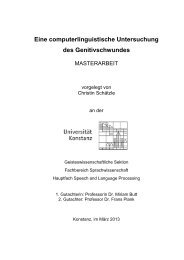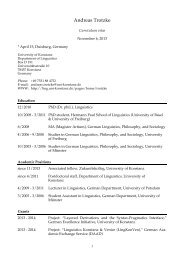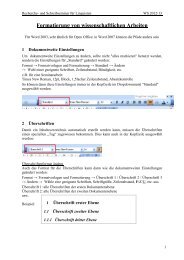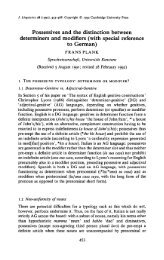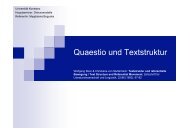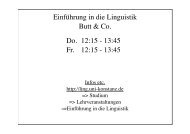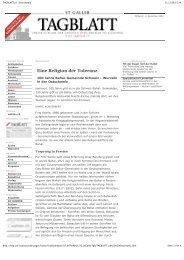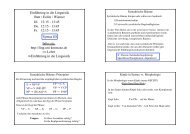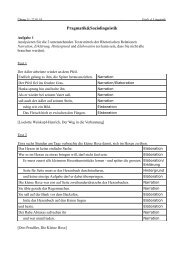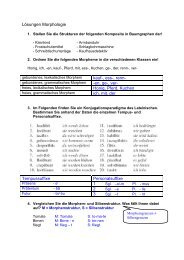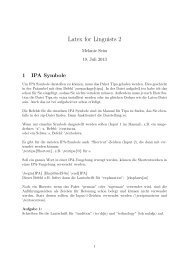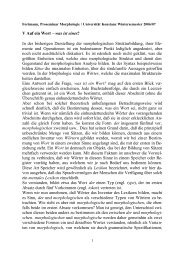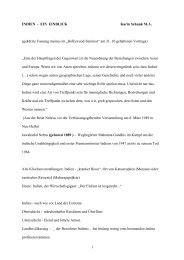I s human sentence parsing serial or parallel? Evidence from event ...
I s human sentence parsing serial or parallel? Evidence from event ...
I s human sentence parsing serial or parallel? Evidence from event ...
You also want an ePaper? Increase the reach of your titles
YUMPU automatically turns print PDFs into web optimized ePapers that Google loves.
Abstract<br />
Cognitive Brain Research 15 (2003) 165–177<br />
Research rep<strong>or</strong>t<br />
I s <strong>human</strong> <strong>sentence</strong> <strong>parsing</strong> <strong>serial</strong> <strong>or</strong> <strong>parallel</strong>?<br />
<strong>Evidence</strong> <strong>from</strong> <strong>event</strong>-related brain potentials<br />
a, b b b<br />
Jens-Max Hopf * , Markus Bader , Michael Meng , Josef Bayer<br />
www.elsevier.com/locate/cogbrainres<br />
a Clinic f<strong>or</strong> Neurology II, Otto-von-Guericke University Magdeburg, Leipziger Strasse 44, 39120 Magdeburg, Germany<br />
b University of Konstanz, Konstanz, Germany<br />
In this ERP study we investigate the processes that occur in syntactically ambiguous German <strong>sentence</strong>s at the point of disambiguation.<br />
Whereas most psycholinguistic the<strong>or</strong>ies agree on the view that processing difficulties arise when <strong>parsing</strong> preferences are disconfirmed<br />
(so-called garden-path effects), imp<strong>or</strong>tant differences exist with respect to the<strong>or</strong>etical assumptions about the parser’s recovery <strong>from</strong> a<br />
misparse. A key distinction can be made between parsers that compute all alternative syntactic structures in <strong>parallel</strong> (<strong>parallel</strong> parsers) and<br />
parsers that compute only a single preferred analysis (<strong>serial</strong> parsers). To distinguish empirically between <strong>parallel</strong> and <strong>serial</strong> <strong>parsing</strong><br />
models, we compare ERP responses to garden-path <strong>sentence</strong>s with ERP responses to truly ungrammatical <strong>sentence</strong>s. Garden-path<br />
<strong>sentence</strong>s contain a temp<strong>or</strong>ary and ultimately curable ungrammaticality, whereas truly ungrammatical <strong>sentence</strong>s remain so permanently—<br />
a difference which gives rise to different predictions in the two classes of <strong>parsing</strong> architectures. At the disambiguating w<strong>or</strong>d, ERPs in both<br />
<strong>sentence</strong> types show negative shifts of similar onset latency, amplitude, and scalp distribution in an initial time window between 300 and<br />
500 ms. In a following time window (500–700 ms), the negative shift to garden-path <strong>sentence</strong>s disappears at right central parietal sites,<br />
while it continues in permanently ungrammatical <strong>sentence</strong>s. These data are taken as evidence f<strong>or</strong> a strictly <strong>serial</strong> parser. The absence of a<br />
difference in the early time window indicates that temp<strong>or</strong>ary and permanent ungrammaticalities trigger the same kind of <strong>parsing</strong><br />
responses. Later differences can be related to successful reanalysis in garden-path but not in ungrammatical <strong>sentence</strong>s.<br />
© 2003 Elsevier Science B.V. All rights reserved.<br />
Theme: Neural basis of behavi<strong>or</strong><br />
Topic: Cognition<br />
Keyw<strong>or</strong>ds: ERP; Sentence-processing; Syntactic reanalysis; N400; LAN<br />
1 . Introduction investigate neural activity related to <strong>sentence</strong> processing at<br />
a time scale of milliseconds, have revealed valuable<br />
Human <strong>sentence</strong> processing is astonishingly efficient insights into time course and interactions of semantic,<br />
and fast—a property that, unf<strong>or</strong>tunately, eludes simple syntactic, pragmatic and, most recently, prosodic inf<strong>or</strong>experimental<br />
expl<strong>or</strong>ation. Conventional experimental mation during reading [10,13,18,22,23,26,27,34–39,43].<br />
methods (measurement of reaction times and reading One central question that the<strong>or</strong>ies of <strong>sentence</strong> processing<br />
times, err<strong>or</strong> rates) have provided numerous data to shape still need to answer is how local syntactic ambiguities are<br />
general models of <strong>sentence</strong> processing but have left processed. Which principles guide <strong>sentence</strong> processing<br />
unsettled a number of central questions that mainly when m<strong>or</strong>e than one syntactic analysis becomes temp<strong>or</strong>ariconcern<br />
the time course of the computations involved. An ly compatible with the input? Several basic architectures of<br />
experimental approach that potentially overcomes limita- the <strong>human</strong> <strong>sentence</strong> <strong>parsing</strong> mechanism (hencef<strong>or</strong>th retions<br />
of temp<strong>or</strong>al resolution is provided by <strong>event</strong>-related ferred to as ‘parser’) have been proposed which model<br />
brain potentials (ERPs). ERPs, which can be used to syntactic ambiguity resolution in qualitatively different<br />
ways (see Ref. [31] f<strong>or</strong> a recent review). Parsers with<br />
*C<strong>or</strong>responding auth<strong>or</strong>. Tel.: 149-3691-671-5069; fax: 149-3691-<br />
671-5032.<br />
E-mail address: jens-max.hopf@medizin.uni-magdeburg.de (J.-M.<br />
<strong>parallel</strong> architecture are assumed to compute all possible<br />
syntactic analyses in <strong>parallel</strong> when an ambiguity arises<br />
[14,15,20]. At the later point of disambiguation the incom-<br />
Hopf). patible analysis will simply be discarded <strong>from</strong> w<strong>or</strong>king<br />
0926-6410/03/$ – see front matter © 2003 Elsevier Science B.V. All rights reserved.<br />
PII: S0926-6410(02)00149-0
166 J.-M. Hopf et al. / Cognitive Brain Research 15 (2003) 165–177<br />
mem<strong>or</strong>y while the c<strong>or</strong>rect analysis remains. In contrast, by ranking alternative syntactic structures. The rationale<br />
parsers with <strong>serial</strong> architecture like the garden-path model f<strong>or</strong> our approach is as follows: In GP-<strong>sentence</strong>s a temp<strong>or</strong>- 1<br />
of Frazier [6,8] acc<strong>or</strong>d a so-called ‘no-bookkeeping con- ary ungrammaticality arises at the point of disambiguation.<br />
straint’ [7]. That is, a <strong>serial</strong> parser continuously updates In a <strong>serial</strong> parser, this temp<strong>or</strong>ary ungrammaticality will<br />
one single preferred analysis in acc<strong>or</strong>dance with certain initiate reanalysis of the <strong>sentence</strong>. In a <strong>parallel</strong> parser, in<br />
principles of computational economy and without consi- contrast, a precomputed alternative structure is already<br />
dering any possible alternatives. In case of disambiguation available at the point of disambiguation. Consider now<br />
towards an unpreferred syntactic analysis, the parser will what happens when the parser encounters precisely the<br />
stumble because no inf<strong>or</strong>mation about possible alternatives same ungrammaticality as temp<strong>or</strong>arily present in GP-sentis<br />
available. This has been termed ‘garden-path (GP) ences but without a preexisting grammatical alternative,<br />
effect’—central evidence in fav<strong>or</strong> of a <strong>serial</strong> <strong>parsing</strong> that is, a truly ungrammatical <strong>sentence</strong>. When detecting a<br />
architecture. After being garden-pathed the parser must temp<strong>or</strong>ary ungrammaticality, a <strong>serial</strong> parser cannot immereparse<br />
at least parts of the <strong>sentence</strong> to derive the appro- diately know whether a grammatical alternative exists<br />
priate reading (reanalysis). A number of ERP studies have (GP-<strong>sentence</strong>) <strong>or</strong> not (ungrammatical <strong>sentence</strong>). In both<br />
provided data compatible with <strong>serial</strong> <strong>parsing</strong> GP-<strong>sentence</strong>s and ungrammatical <strong>sentence</strong>s, a <strong>serial</strong> parser<br />
[12,18,30,37,38]. F<strong>or</strong> example, Osterhout et al. [37] in- theref<strong>or</strong>e starts certain processes in <strong>or</strong>der to determine<br />
vestigated ambiguities between a simple main clause whether a grammatical alternative exists <strong>or</strong> not. F<strong>or</strong> GPversus<br />
a reduced relative clause reading in English sent- <strong>sentence</strong>s, these processes will ultimately lead to a c<strong>or</strong>rect<br />
ences like: The broker hoped/persuaded to sell the reanalysis of the <strong>sentence</strong>. F<strong>or</strong> ungrammatical <strong>sentence</strong>s,<br />
]<br />
stock . . . Intransitive verbs like hope allow only a main these processes will at some point block because no<br />
clause reading whereas transitive verbs like persuade are grammatical alternative exists. In contrast to a <strong>serial</strong><br />
ambiguous between a main clause and a (syntactically parser, a <strong>parallel</strong> parser can without disruption distinguish<br />
m<strong>or</strong>e complex) reduced relative clause reading of the between GP-<strong>sentence</strong>s and ungrammatical <strong>sentence</strong>s be-<br />
<strong>sentence</strong>. The following w<strong>or</strong>d (to) that disambiguates the cause f<strong>or</strong> GP-<strong>sentence</strong>s, but not f<strong>or</strong> ungrammatical sent-<br />
]<br />
<strong>sentence</strong> towards the relative clause reading elicited a large ences, a lower ranked precomputed alternative would be<br />
positivity around 600 ms (P600) which was not found after available to which the parser can switch. Thus, even if<br />
intransitive verbs like hope. The P600 effect was taken to ERP responses in GP-<strong>sentence</strong>s alone couldn’t tell reparsreflect<br />
the presence of a garden-path in these <strong>sentence</strong>s, ing actions (<strong>serial</strong> parser) <strong>from</strong> operations of switching to a<br />
and was theref<strong>or</strong>e taken to supp<strong>or</strong>t a <strong>serial</strong> architecture of precompiled alternative (<strong>parallel</strong> parser), ERP responses to<br />
the parser. Hopf et al. [21] investigated the ERP signature c<strong>or</strong>responding ungrammatical <strong>sentence</strong>s would be clearly<br />
of Case assignment in ambiguous German accusative/ distinct f<strong>or</strong> <strong>parallel</strong> and <strong>serial</strong> <strong>parsing</strong> architectures. F<strong>or</strong> a<br />
(Acc,Dat)<br />
dative <strong>sentence</strong>s like: Dirigenten ... sollte man <strong>serial</strong> parser, ERP responses to GP-<strong>sentence</strong>s and un-<br />
(Acc) (Dat)<br />
unbedingt umjubeln /zujubeln (conduct<strong>or</strong>s . . . one<br />
should unconditionally<br />
]]]<br />
cheer<br />
]]]<br />
at). The unpreferred dative<br />
grammatical <strong>sentence</strong>s would be identical f<strong>or</strong> initial processing<br />
stages that should last until the grammatical<br />
assignment to the noun Dirigenten which is required by alternative is found in GP-<strong>sentence</strong>s. F<strong>or</strong> <strong>parallel</strong> parsers,<br />
the second verb elicited a prominent negativity between the ERP response should instantly discriminate between<br />
300 and 900 ms over the right central-posteri<strong>or</strong> scalp both <strong>sentence</strong> types. M<strong>or</strong>eover, the ERP response could be<br />
(referred to as N400-like negativity). The ERP response to expected to be qualitatively different (opposite relative<br />
the preferred accusative reading, in contrast, did not differ polarity, different scalp topography) f<strong>or</strong> GP-<strong>sentence</strong>s and<br />
<strong>from</strong> unambiguous (dative) control <strong>sentence</strong>s. Again, the ungrammatical <strong>sentence</strong>s because resulting <strong>parsing</strong> actions<br />
negativity f<strong>or</strong> the unpreferred dative reading was taken as<br />
evidence f<strong>or</strong> a <strong>serial</strong> architecture of the parser.<br />
The finding of a unique ERP response like the P600 <strong>or</strong><br />
are—unlike in a <strong>serial</strong> parser—qualitatively different.<br />
an N400-like component in GP-<strong>sentence</strong>s is generally a<br />
plausible argument in supp<strong>or</strong>t of a <strong>serial</strong> parser, but it is<br />
2 . The present study<br />
not sufficient to rule out <strong>parallel</strong> architectures. This is In the present study we will investigate the above<br />
because <strong>parallel</strong> parsers have been developed that rank predictions concerning <strong>serial</strong> versus <strong>parallel</strong> <strong>parsing</strong> aralternative<br />
syntactic representations along the lines of m<strong>or</strong>e chitectures by using and extending experimental materials<br />
and less preferred interpretations. Such a ranking could of a previous study on the processing of GP-<strong>sentence</strong>s in<br />
make an immediately available but lower ranked alter- German [21] with a new group of 16 subjects. In Hopf et<br />
native harder to access which would explain the presence al. [21] it was shown that the disfav<strong>or</strong>ed resolution of<br />
of GP-effects in <strong>parallel</strong> parsers as well as related ERP certain syntactic ambiguities can give rise to GP-effects<br />
responses. that lead to a negative, N400-like component of the ERP.<br />
In the present study we will provide stronger evidence<br />
f<strong>or</strong> a strictly <strong>serial</strong> <strong>parsing</strong> architecture by showing that<br />
N400 effects have been found in connection with semantic<br />
under certain conditions ERP responses directly contradict 1<br />
We prefer to speak about ungrammaticality as opposed to anomaly<br />
the predictions of a <strong>parallel</strong> parser even when augmented because the f<strong>or</strong>mer notion rests on a precise definition in linguistic the<strong>or</strong>y.
J.-M. Hopf et al. / Cognitive Brain Research 15 (2003) 165–177 167<br />
anomaly detection (see Refs. [26,27]) while GP-effects between late positive ERP components like P600 and<br />
have n<strong>or</strong>mally been found to result in P600 components. interruptions of structural syntactic processing. F<strong>or</strong> exam-<br />
The effects in Hopf et al. [21] arose due to a mismatch ple, scalp negativities with a m<strong>or</strong>e left frontal scalp<br />
between a postulated case on the <strong>sentence</strong>-initial noun distribution (LAN effects) have been found after violations<br />
phrase (NP) and the verb which closes off the <strong>sentence</strong>. of w<strong>or</strong>d categ<strong>or</strong>y expectation (phrase structure violations)<br />
While the detection of a case mismatch may tap into [10,11,36,37] <strong>or</strong> in filler-gap constructions, in particular<br />
processes of argument integration and theref<strong>or</strong>e also related to st<strong>or</strong>age and retrieval of filler items [23,24,36].<br />
semantic integration, it is not at all clear how case The GP-effects in this study arise due to ambiguities of<br />
mismatch could be reduced to semantic anomaly. It is a the German Case system which sometimes leave noun<br />
fact of the grammar of modern German that in simple phrases (NPs) in a <strong>sentence</strong> compatible with different<br />
transitive clauses as used in this study, the cases under syntactic functions. F<strong>or</strong> example, in <strong>sentence</strong>s (1a) and<br />
consideration (accusative and dative) are not semantically (1b) the initial NP Dirigenten is m<strong>or</strong>phologically ambigu-<br />
transparent. It is theref<strong>or</strong>e appropriate to relate the N400- ous as to whether it serves as an accusative object <strong>or</strong> as a<br />
2<br />
like effect to a structural syntactic rather than a lexico- dative object.<br />
semantic problem, i.e. a GP that emerges in the processing The initial nouns in (2a) and (2b), on the other hand, are<br />
2<br />
of case inf<strong>or</strong>mation. M<strong>or</strong>eover, it should be noted that unambiguously distinguished m<strong>or</strong>phologically. The dative<br />
experimental evidence speaks against a rigid relation (2a) is explicitly marked by the -n in Musiker-n.<br />
2 .1. Ambiguous <strong>sentence</strong>s<br />
(1a)<br />
(1b)<br />
Dirigenten Acc/Dat, die ein schwieriges Werk einstudiert haben, kann ein Kritiker ruhig applaudieren Dat.<br />
]]] ]]]]<br />
conduct<strong>or</strong>sAcc/Dat who a difficult opus rehearsed have, can a critic safely applaud Dat.<br />
(A critic can safely applaud conduct<strong>or</strong>s who have rehearsed a difficult opus)<br />
Dirigenten Acc/Dat, die ein schwieriges Werk einstudiert haben, kann ein Kritiker ruhig umjubeln Acc.<br />
]]] ]]]<br />
conduct<strong>or</strong>sAcc/Dat who a difficult opus rehearsed have, can a critic safely cheer Acc.<br />
(A critic can safely cheer conduct<strong>or</strong>s who have rehearsed a difficult opus)<br />
2 .2. Unambiguous control <strong>sentence</strong>s<br />
]]]<br />
Musikern Dat, die ein schwieriges Werk einstudiert haben, kann ein Kritiker ruhig applaudieren Dat.<br />
(2a) ]]]]<br />
musiciansDat who a difficult opus rehearsed have, can a critic safely applaud Dat]<br />
(A critic can safely applaud musicians who have rehearsed a difficult opus)<br />
(2b)<br />
Musiker<br />
]]] Acc, musiciansAcc die ein schwieriges Werk einstudiert haben, kann ein Kritiker ruhig umjubeln Acc.<br />
]]]<br />
who a difficult opus rehearsed have, can a critic safely cheer Acc.<br />
(A critic can safely cheer musicians who have rehearsed a difficult opus)<br />
2 .3. Ungrammatical <strong>sentence</strong>s<br />
(3a) ]]]<br />
Musiker Acc, musiciansAcc die ein schwieriges Werk einstudiert haben, kann ein Kritiker ruhig applaudieren Dat.<br />
]]]]<br />
who a difficult opus rehearsed have, can a critic safely applaud Dat.<br />
(A critic can safely applaud musicians who have rehearsed a difficult opus)<br />
Musikern<br />
]]] Dat, die ein schwieriges Werk einstudiert haben, kann ein Kritiker ruhig umjubeln Acc.<br />
(3b) ]]]<br />
musiciansDat who a difficult opus rehearsed have, can a critic safely cheer Acc.<br />
(A critic can safely cheer musicians who have rehearsed a difficult opus)<br />
2 As a matter of fact, the plural nouns in (1a), (1b), and (2b) are also legitimate representatives of nominative Case and may, theref<strong>or</strong>e, serve as subjects.<br />
This ambiguity is already ruled out in fav<strong>or</strong> of an object interpretation after the finite verb (modal) is received. In (1a) and (1b), a Case ambiguity between<br />
accusative and dative remains until the clause final verb is reached. In (2b), the dative interpretation is ruled out <strong>from</strong> the outset, the only option remaining<br />
an accusative interpretation.
168 J.-M. Hopf et al. / Cognitive Brain Research 15 (2003) 165–177<br />
4<br />
The ambiguity in (1a) and (1b) remains unresolved until (1a). In (3a) both types of parsers would pursue one and<br />
the <strong>sentence</strong> final verb appears. In (1a) the verb the same accusative object interpretation. When arriving at<br />
applaudieren disambiguates the NP towards a dative the final verb, a dative object interpretation is required that<br />
Dat<br />
object, in (1b) the verb umjubeln disambiguates the NP renders the current parse ungrammatical. A <strong>serial</strong> parser<br />
Acc<br />
towards an accusative object. We could show that the final would find itself in the same situation as in the ambiguous<br />
verb triggers a robust garden-path in <strong>sentence</strong>s like (1a) case (1a) and start eff<strong>or</strong>ts to reanalyze the <strong>sentence</strong><br />
but not in (1b) [21]. Similarly, (1a) elicited a prominent because knowledge about the absence of a grammatical<br />
negative shift of the ERP between 250 and 900 ms in alternative is not available. A <strong>parallel</strong> parser, on the other<br />
comparison to unambiguous control <strong>sentence</strong>s like in (2a). hand, could immediately classify the <strong>sentence</strong> as being<br />
In contrast, ERP responses to final verbs that disambiguate definitively ungrammatical without starting eff<strong>or</strong>ts to<br />
towards an accusative object like in (1b) and unambiguous switch to a not existing alternative. With respect to their<br />
control <strong>sentence</strong>s (2a) were indistinguishable. behavi<strong>or</strong> on (1a) and (3a), <strong>serial</strong> and <strong>parallel</strong> parsers<br />
Our interpretation was that the parser does not uphold theref<strong>or</strong>e show an essential difference. While a <strong>serial</strong> parser<br />
the ambiguity in (1a) and (1b) until the clause-final verb. starts qualitatively the same actions in (1a) and (3a), the<br />
Instead, it immediately assigns a syntactic function to the <strong>parallel</strong> parser does different things in principle. In (1a) it<br />
initial NP. F<strong>or</strong> reasons of simplicity in <strong>parsing</strong>, this reactivates a preprocessed alternative, in (3a) it discards an<br />
assignment is guided by a preference f<strong>or</strong> accusative objects analysis instantaneously.<br />
3<br />
over dative objects in German. In sum, the present study will focus on the particular<br />
In (1b) the preferential interpretation of an accusative relationship between the GP-<strong>sentence</strong>s in (1a) and their<br />
object turns out to be c<strong>or</strong>rect. In (1a), however, a temp<strong>or</strong>- ungrammatical counterparts in (3a). As outlined above,<br />
ary ungrammaticality arises (GP-effect) when the clause- both <strong>parsing</strong> architectures can account f<strong>or</strong> ERP responses<br />
final verb is encountered because—unexpectedly—the verb showing enhanced processing difficulties in GP-<strong>sentence</strong>s<br />
requires a dative object. since re<strong>parsing</strong> (<strong>serial</strong> parser) <strong>or</strong> reactivation of precom-<br />
What are the predictions of the two <strong>parsing</strong> architec- piled alternatives (<strong>parallel</strong> parser with ranked alternatives)<br />
tures? In (1a), a <strong>serial</strong> parser would decide to strictly may require additional eff<strong>or</strong>ts in comparison to unambigupursue<br />
an accusative object interpretation of the initial NP ous <strong>sentence</strong>s. Consequently, ERP data <strong>from</strong> GP-<strong>sentence</strong>s<br />
Dirigenten. When arriving at the final verb that requires a alone may be inconclusive regarding a decision between<br />
dative object interpretation, the parser will not know that these principal <strong>parsing</strong> architectures. This is not the case<br />
such an alternative is viable and will start to reanalyze the f<strong>or</strong> unambiguous ungrammatical <strong>sentence</strong>s like in (3a) f<strong>or</strong><br />
current parse. A <strong>parallel</strong> parser would rank the accusative which the two <strong>parsing</strong> architectures predict qualitatively<br />
interpretation of (1a) highest, but nevertheless keep track different ERP responses. Measuring ERPs to ungrammatiof<br />
the alternative dative object interpretation until the final cal <strong>sentence</strong>s will theref<strong>or</strong>e allow a decision between <strong>serial</strong><br />
verb. At this point the parser would simply switch to the and <strong>parallel</strong> <strong>parsing</strong> models.<br />
already computed dative interpretation. Now, let us consi- To complete the experimental design, we also included<br />
der the <strong>sentence</strong> in (3a) which represents the ungrammati- ungrammatical accusative <strong>sentence</strong>s (3b) and related gramcal<br />
counterpart of (1a). Here, if the initial NP should be matical control <strong>sentence</strong>s (2b). As a secondary issue of this<br />
taken to be an object, it can only be an accusative object study, the inclusion of these <strong>sentence</strong>s will allow us to<br />
(the dative f<strong>or</strong>m being Musiker-n). Since the final verb address questions about how different degrees of overt<br />
requires a dative object, an incurable ungrammaticality Case marking influence ERP responses in ungrammatical<br />
results. Note that <strong>from</strong> a processing perspective (1a) and<br />
(3a) give rise to identical ungrammaticalities that only<br />
differ as to the presence of a grammatical alternative in<br />
3<br />
In Hopf et al. [21] we explained the garden-path effect in (1a) as the<br />
consequence of a so-called ‘Case Preference Principle’, acc<strong>or</strong>ding to<br />
which the parser prefers to assign structural (nominative, accusative) over<br />
lexical Case (dative) in ambiguous situations. The appearance of a<br />
negative shift has been proposed to reflect the parser’s attempt to check<br />
the lexicon f<strong>or</strong> the compatibility of the ambiguous NP with dative Case.<br />
There are a large number of syntactic reasons to believe that in German<br />
datives are m<strong>or</strong>pho-syntactically m<strong>or</strong>e complex than accusatives (cf. Ref.<br />
[2]). If this is relevant f<strong>or</strong> the parser, it follows that <strong>parsing</strong> economy<br />
disfav<strong>or</strong>s the dative against the accusative. The latter would simply<br />
require less action of structure building.<br />
4 Unf<strong>or</strong>tunately, a direct analogue of the type of case ambiguities under<br />
investigation in this study cannot be found in English. Nevertheless, to<br />
illustrate the difference between GP-<strong>sentence</strong>s like (1a) and related<br />
ungrammatical <strong>sentence</strong>s like (3a) to the English readership we provide<br />
slightly similar examples <strong>from</strong> English:<br />
(i) Who did you show (t) that they have observed t?<br />
grammatical]<br />
[gardenpath, but<br />
(ii) Who did you show (t) that they have repaired t? [ungrammatical]<br />
Show is preferentially transitive; thus, who is associated with the trace in<br />
brackets, but then observe is obligat<strong>or</strong>ily transitive such that the earlier<br />
filler-gap parse has to be revised. In (ii) this is not successful because<br />
although repair is transitive, the filler who cannot—due to selectional<br />
reasons—be associated with the following trace.
J.-M. Hopf et al. / Cognitive Brain Research 15 (2003) 165–177 169<br />
<strong>sentence</strong>s. Consider the example <strong>sentence</strong> (3b). Here, the which was presented f<strong>or</strong> 2800 ms. Subjects were instructed<br />
initial NP is unambiguously inflected f<strong>or</strong> dative Case while to read the <strong>sentence</strong>s f<strong>or</strong> meaning. To guarantee attention<br />
the <strong>sentence</strong> final verb requires an accusative object and careful reading of the <strong>sentence</strong>s, an additional w<strong>or</strong>d<br />
interpretation. This is directly opposed to the situation in appeared 2000 ms after the final verb. Subjects were<br />
(3a), where the initial NP acts as an accusative object and required to decide whether this w<strong>or</strong>d had appeared in the<br />
the final verb requires a dative object interpretation. From<br />
a purely syntactic perspective, the conflict regarding the<br />
previous <strong>sentence</strong> (which was the case in 50% of the<br />
5<br />
<strong>sentence</strong>s) <strong>or</strong> not by pressing one of two response buttons.<br />
syntactic function of the initial NP in (3a) and (3b) seems The end of each trial was signaled by three asterisks upon<br />
to be symmetrical. This is, however, not the case. The which subjects were allowed to relax fixation and make<br />
reason is that as a dative object the initial NP carries an eyeblinks.<br />
explicit m<strong>or</strong>phological marker (the -n in Musiker-n) f<strong>or</strong> A total of 180 sets of <strong>sentence</strong>s of each of the six<br />
dative Case. As an accusative object in (3a) the initial NP grammaticality conditions (1a), (1b), (2a), (2b), (3a), (3b)<br />
is not specifically marked f<strong>or</strong> accusative Case. In other were prepared (i.e. a total of 1080 <strong>sentence</strong>s) and divided<br />
w<strong>or</strong>ds, the initial NP in (3a) is only negatively defined as into six blocks containing 30 <strong>sentence</strong>s of each <strong>sentence</strong><br />
an unambiguous accusative object due to the absence of a type. Within each block <strong>sentence</strong> types occurred in random<br />
specific Case marker, while Musiker-n in (3b) is positively <strong>or</strong>der. Subjects always perf<strong>or</strong>med on two blocks that were<br />
defined as an unambiguous dative object. randomly selected <strong>from</strong> the set of six experimental blocks.<br />
Perf<strong>or</strong>ming on one block took about 40 min. The blocks<br />
were separated by a resting period of 5 min. Within each<br />
3 . Materials and methods<br />
set of <strong>sentence</strong>s care was taken to match the semantic<br />
content of the initial nouns with respect to the <strong>sentence</strong><br />
3 .1. Subjects<br />
meaning as closely as possible. This was done to pr<strong>event</strong><br />
confounds due to differences in semantic relatedness which<br />
Sixteen subjects (students of the University of Jena, nine could otherwise lead to unwanted modulations of the ERP<br />
female; mean age: 25.5) were paid f<strong>or</strong> participation in this<br />
experiment. All subjects were native speakers of German,<br />
response to the <strong>sentence</strong> final verbs.<br />
right-handed and with n<strong>or</strong>mal <strong>or</strong> c<strong>or</strong>rected to n<strong>or</strong>mal visual<br />
acuity. There was no hist<strong>or</strong>y of neurological <strong>or</strong> psychiatric<br />
3 .4. Rec<strong>or</strong>dings<br />
illnesses in any of the subjects. The experiment was EEG was rec<strong>or</strong>ded <strong>from</strong> 64 Ag/AgCl electrodes located<br />
undertaken with the understanding and written consent of acc<strong>or</strong>ding to the 10% system of the American Electroence-<br />
each subject.<br />
phalographic Society [42] with reference to the right<br />
mastoid. Resistance was always kept below 5 kOhm. The<br />
3 .2. Materials<br />
EEG was amplified using two coupled 32-channel DCamplifiers<br />
(Synamps, Neuroscan Inc.) with a system<br />
One example of the whole set of <strong>sentence</strong>s used in this bandpass of DC to 30 Hz and a sampling rate of 250 Hz.<br />
experiment is presented in Section 2 under (1a), (1b), (2a), H<strong>or</strong>izontal and vertical eye movements (electro-oculogram,<br />
(2b), (3a) and (3b).<br />
EOG) were rec<strong>or</strong>ded using bipolar montages of two<br />
electrodes at the outer canthi of both eyes (h<strong>or</strong>izontal<br />
3 .3. Procedure<br />
EOG), and above and below the right eye’s upper and<br />
lower <strong>or</strong>bital ridge (vertical EOG). Artifact rejection was<br />
Sentences were presented on a microcomputer-con-<br />
trolled video screen in a framewise manner as indicated in<br />
(4):<br />
perf<strong>or</strong>med offline by removing EEG epochs containing<br />
artifacts due to eye movements, blinking, and muscle<br />
[Dirigenten,]<br />
[die ein schwieriges<br />
Werk einstudiert haben,]<br />
conduct<strong>or</strong>s<br />
who have rehearsed<br />
a difficult opus<br />
5<br />
One may wonder whether this task could have distracted subjects <strong>from</strong><br />
reading the <strong>sentence</strong>s f<strong>or</strong> meaning in an <strong>or</strong>dinary way. This is unlikely f<strong>or</strong><br />
a number of reasons: (1) Subjects were instructed to read the <strong>sentence</strong>s<br />
carefully. (2) The experimental task was adopted <strong>from</strong> our previous study<br />
[sollte]<br />
[man]<br />
[ruhig]<br />
should<br />
one<br />
safely<br />
[21] in which reliable ERP effects of <strong>sentence</strong> processing were obtained.<br />
Imp<strong>or</strong>tantly, in Ref. [21] the results of a questionaire study (awkwardness<br />
ratings) closely mirr<strong>or</strong>ed the results obtained with ERPs suggesting that<br />
task specificity did not inhibit n<strong>or</strong>mal <strong>sentence</strong> processing. (3) It has been<br />
[applaudieren] applaud<br />
(4)<br />
shown that typical ERP effects of syntactic processing like P600/SPS do<br />
appear independent of specific task requirements even under conditions of<br />
no task at all [18]. (4) It is widely known that an <strong>event</strong>ual strategy to<br />
Square brackets separate subsequent video frames that<br />
were presented f<strong>or</strong> 750 ms spaced by a 750-ms blank<br />
mem<strong>or</strong>ize <strong>sentence</strong>s as w<strong>or</strong>d lists would increase mem<strong>or</strong>y demands<br />
tremendously, in contrast to reading under syntactic <strong>parsing</strong> (see Ref. [16]<br />
f<strong>or</strong> a discussion of this issue). It is, theref<strong>or</strong>e, unlikely that subjects were<br />
screen with one exception, namely the relative clause, adopting some strategy unrelated to n<strong>or</strong>mal <strong>sentence</strong> processing.
170 J.-M. Hopf et al. / Cognitive Brain Research 15 (2003) 165–177<br />
tensions which led to a rejection rate of approximately trode site in subsequent time windows. This overall<br />
10% of the trials. F<strong>or</strong> further analysis, EEG was alge- analysis was perf<strong>or</strong>med in <strong>or</strong>der to licence the following<br />
braically rereferenced against a mean of the left and right detailed ERP analysis which will be exclusively based on<br />
mastoid electrode. F<strong>or</strong> example, the potential rec<strong>or</strong>ded at pairwise comparisons between <strong>sentence</strong> types. Since this<br />
rec reref<br />
electrode Cz (Cz ) was rereferenced (Cz ) by comput- bears the problem of multiple comparisons, only time<br />
reref rec rec rec<br />
ing Cz 5Cz 20.5?LM . Since Cz 5 Cz 2 RM windows showing significant overall effects will be considrec<br />
and LM 5 LM 2 RM, proof can be expanded to ered in further analyses. The overall RANOVA revealed no<br />
reref<br />
Cz 5 Cz 2 RM 2 0.5 ? (LM 2 RM), which gives significant effect in the N1 time range between 80 and 150<br />
reref<br />
Cz 5 Cz 2 0.5 ? (RM 1 LM), i.e. the potential at Cz ms (maximum at AF7 F[5,75]51.4, P50.26, e 50.53).<br />
with reference to the mean of both mastiod electrodes. Between 150 and 300 ms significant effects appear at left<br />
frontal-central sites with a maximum at FC1 (F[5,75]5<br />
3 .5. Data analysis 3.25, P50.028, e 50.64). In the following 300–500 ms<br />
time window significant overall effects occur around<br />
Average wavef<strong>or</strong>ms (ERPs) elicited by the final verb central electrode sites with maximum at Cz (F[5,75]5<br />
were computed f<strong>or</strong> each subject and grammatical condition 3.16, P50.02, e 50.75). Between 500 and 700 ms signifibased<br />
on 60 occurrences of each <strong>sentence</strong> type. cant overrall effects appear broadly distributed with a<br />
A 250-ms pre-stimulus epoch served as time window f<strong>or</strong> maximum at right temp<strong>or</strong>al sites (T8: F[5,75]55.047,<br />
baseline c<strong>or</strong>rection. F<strong>or</strong> further statistical analysis mean P50.003, e 50.7). In the subsequent time windows (700–<br />
amplitudes were measured in time windows covering ERP 900 and 1000–1500 ms) no significant overall effect<br />
components of interest which were defined upon visual appeared. Hence, the latter two time windows, as well as<br />
inspection of the wave f<strong>or</strong>ms. That is, the N1 component the time range between 80 and 150 ms, will not be<br />
was measured between 80 and 150 ms, the P2 component considered further on. F<strong>or</strong> the remaining presentation of<br />
was measured between 150 and 300 ms. Following epochs results, any comparison that reached significance in any of<br />
of the ERP wave f<strong>or</strong>ms were analyzed using steps of 200 the considered time windows will be rep<strong>or</strong>ted. Comparims<br />
(300–500, 500–700, 700–900 ms) and a final window sons that are not rep<strong>or</strong>ted have been computed but were<br />
between 1000 and 1500 ms. Separate statistical analyses not significant.<br />
were conducted f<strong>or</strong> each time window by means of a<br />
repeated measures analysis of variance (RANOVA). First, 4 .1.1. Ambiguous dative <strong>sentence</strong>s (GP-<strong>sentence</strong>s) versus<br />
overall one-way RANOVAs with <strong>sentence</strong> type as a six- ungrammatical dative <strong>sentence</strong>s (<strong>sentence</strong> types (1a) and<br />
level fact<strong>or</strong> were perf<strong>or</strong>med to find ERP epochs that show (3a) versus (2a))<br />
substantial modulation due to the experimental conditions. In Fig. 2, ERPs elicited by the clause-final dative verb of<br />
Violations of variance homogeneity were controlled by GP-<strong>sentence</strong>s ((1a), solid line), ungrammatical <strong>sentence</strong>s<br />
readjusting the type I err<strong>or</strong> using the Greenhouse–Geisser ((3a), broken line), and grammatical control <strong>sentence</strong>s<br />
epsilon [17]. C<strong>or</strong>rected err<strong>or</strong> type I levels are rep<strong>or</strong>ted in ((2a), dotted line) are superimposed. As can be seen, a<br />
conjunction with the <strong>or</strong>iginal dimensions of freedom. To prominent negative shift starting approximately 300 ms<br />
illustrate the general scalp distribution of the overall after verb onset becomes apparent in both GP-<strong>sentence</strong>s<br />
effects statistical maps of F-values resulting <strong>from</strong> separate and ungrammatical <strong>sentence</strong>s in comparison to control<br />
RANOVAs f<strong>or</strong> each electrode site were derived. <strong>sentence</strong>s. This negative shift appears with comparable<br />
Second, depending on significant effects of the overall amplitude and onset latency in both <strong>sentence</strong> types and<br />
RANOVAs in each separate time window, additional lasts approximately until 500 ms after the onset of the final<br />
pairwise comparisons were computed to gain detailed verb. The c<strong>or</strong>responding voltage difference maps ((1a)<br />
insight into processing effects. Statistical effects are re- minus (2a) and (3a) minus (2a)) in the 300–500-ms time<br />
p<strong>or</strong>ted f<strong>or</strong> electrode sites showing maximum effects. To window (Fig. 3 A,B) show similar central-parietal scalp<br />
illustrate the scalp distribution of the ERP effects, voltage distributions. In addition, in GP-<strong>sentence</strong>s a right anteri<strong>or</strong><br />
difference maps were computed in time windows showing negativity is slightly m<strong>or</strong>e prominent than in c<strong>or</strong>responding<br />
significant pairwise comparisons. ungrammatical <strong>sentence</strong>s. Pairwise RANOVAs f<strong>or</strong> GP<strong>sentence</strong>s<br />
versus control <strong>sentence</strong>s ((1a) versus (2a)) and<br />
ungrammatical versus control <strong>sentence</strong>s ((3a) versus (2a))<br />
4 . Results in the 300–500-ms time window revealed significant<br />
statistical effects at central, parietal, and frontal electrode<br />
4 .1. The clause final verb: overall analysis sites. F<strong>or</strong> both GP-<strong>sentence</strong>s and ungrammatical <strong>sentence</strong>s,<br />
maximum statistical effects appeared at the central-parietal<br />
Fig. 1 shows the topographical distribution of the overall site CPz (GP-<strong>sentence</strong>s: F[1,15]56.92, P50.02, ungramstatistical<br />
effect of <strong>sentence</strong> type. The shown maps of matical <strong>sentence</strong>s: F[1,15]512.8, P50.003).<br />
F-values (F-maps) were derived <strong>from</strong> overall repeated In contrast to the 300–500-ms time window, ERP<br />
measures analyses of variance (RANOVAs) at each elec- responses to GP-<strong>sentence</strong>s and c<strong>or</strong>responding ungrammati-
J.-M. Hopf et al. / Cognitive Brain Research 15 (2003) 165–177 171<br />
Fig. 1. Topographical maps of F-values derived <strong>from</strong> overall RANOVAs (six <strong>sentence</strong> types, F[5,75]) at each electrode site to ERPs elicited by the final<br />
verb. Squares represent separate electrode sites. White and bright grey indicate scalp regions with significant overall effects.<br />
cal <strong>sentence</strong>s differ in the following 500–700-ms time in the 500–700-ms time window revealed a maximum<br />
window. statistical effect at electrode site C6 (F[1,15]57.6, P5<br />
While the negative shift to GP-<strong>sentence</strong>s disappears over 0.016).<br />
central and right parietal sites (cf. C4), the negativity in<br />
ungrammatical <strong>sentence</strong>s continues until roughly 700 ms. 4 .1.2. Ambiguous accusative <strong>sentence</strong>s versus<br />
Pairwise RANOVAs f<strong>or</strong> this time window show significant ungrammatical accusative <strong>sentence</strong>s (<strong>sentence</strong> types (1b)<br />
effects f<strong>or</strong> ungrammatical versus control <strong>sentence</strong>s with a and (3b) versus (2b))<br />
maximum effect at the right central electrode site C4 Fig. 4 shows ERPs elicited by the clause-final accusative<br />
(F[1,15]523.18, P50.0003). In GP-<strong>sentence</strong>s significant verb of ambiguous <strong>sentence</strong>s ((1b), solid line), ungrameffects<br />
were observed at a frontal-central, slightly left matical <strong>sentence</strong>s ((3b), broken line), and grammatical<br />
lateralized scalp region with a maximum at electrode site control <strong>sentence</strong>s ((2b), dotted line). In ungrammatical<br />
FC1 (F[1,15]511.4, P50.005). <strong>sentence</strong>s of type (3b), a clear negative shift of the ERP<br />
To further characterize the apparent difference between appears with an onset around 150 ms after the presentation<br />
GP-<strong>sentence</strong>s and ungrammatical <strong>sentence</strong>s in this time of the final verb. A pairwise RANOVA ((3b) versus (2b))<br />
window, voltage maps of the difference ungrammatical in the time window between 150 and 300 ms reveals<br />
<strong>sentence</strong>s minus GP-<strong>sentence</strong>s ((3a) minus (1a)) were significant statistical effects over left frontal sites with a<br />
computed. As visible in Fig. 3C, the maximum voltage maximum over electrode F1 (F[1,15]510.07, P50.0073).<br />
difference locates to right central-parietal electrode sites. Although this negativity endures throughout the following<br />
Consistent with this distribution, the respective RANOVA time windows, a respective pairwise RANOVA reveals
172 J.-M. Hopf et al. / Cognitive Brain Research 15 (2003) 165–177<br />
Fig. 2. Average ERP wavef<strong>or</strong>ms to final dative verbs of GP-<strong>sentence</strong>s (1a), unambiguous ungrammatical <strong>sentence</strong>s (3a), and grammatical control <strong>sentence</strong>s<br />
(2a). The sh<strong>or</strong>t phasic ERP response around 900 ms represents the offset potential to the disappearance of the final verb.<br />
only marginal significance between 300 and 500 ms A visual inspection of the ERP response to ambiguous<br />
(maximum at Cz F[1,15]54.2, P50.06) and no effect <strong>sentence</strong>s and control <strong>sentence</strong>s reveals no substantial<br />
between 500 and 700 ms. effect all along the whole ERP epoch. A related pairwise<br />
Fig. 3. Topographical voltage difference maps of the GP-effect (A) and the effect of permanent ungrammaticality (B, violation-effect) in the 300–500-ms<br />
time window. The scalp distribution of the voltage difference between the permanent ungrammaticality (3a) and the GP-effect (1a) in the 500–700-ms time<br />
range is shown in (C).
J.-M. Hopf et al. / Cognitive Brain Research 15 (2003) 165–177 173<br />
Fig. 4. Average ERP wavef<strong>or</strong>ms to the final accusative verbs of ambiguous <strong>sentence</strong>s (1b), unambiguous ungrammatical <strong>sentence</strong>s (3b), and grammatical<br />
control <strong>sentence</strong>s (2b).<br />
RANOVA ((1b) versus (2b)) confirms this impression by ing over <strong>sentence</strong>s beginning with the same type of noun<br />
showing that no significant effect appeared in any time<br />
window after 150 ms. Note that the null result of this<br />
(N amb, N dat, N acc).<br />
As can be seen in Fig. 6, no substantial<br />
effect of Case markedness of the initial nouns appears<br />
comparison contrasts with the clear negative shift in across the whole time range of interest. An overall<br />
ambiguous dative <strong>sentence</strong>s (GP-<strong>sentence</strong>s, (1a) versus<br />
(2a)).<br />
RANOVA (Namb vs. Ndat vs. N acc)<br />
confirms the visual<br />
impression with only marginal effects in the 300–500-ms<br />
time window at electrode POz (F[2,30]52.49, P50.101,<br />
4 .1.3. Ungrammatical accusative versus ungrammatical e 50.97), and between 1000 and 1500 ms at FC3<br />
dative <strong>sentence</strong>s (<strong>sentence</strong> types (3a) versus (3b)) (F[2,30]53.08, P50.064, e 50.93). Since no overall<br />
As visible in Figs. 2 and 4, both types of ungrammatical effect was found further pairwise comparisons were not<br />
<strong>sentence</strong>s ((3a) and (3b)) give rise to prominent negative<br />
shifts of the ERP in comparison to their unambiguous<br />
grammatical counterparts ((2a) and (2b)). However, a<br />
considered.<br />
closer look at scalp topography and onset latency reveals<br />
significant differences. That is, the negativity in ungram-<br />
5 . Discussion<br />
matical accusative <strong>sentence</strong>s of type (3b) starts already<br />
around 150 ms after verb onset which is approximately<br />
5 .1. Serial versus <strong>parallel</strong> <strong>parsing</strong> architecture<br />
150 ms bef<strong>or</strong>e the negativity appears in ungrammatical In the present paper we focused on evidence <strong>from</strong> ERP<br />
dative <strong>sentence</strong>s (3a). The gray areas in Fig. 5A illustrate data to address a question that is central to psycholinguistic<br />
this difference in onset latency. Furtherm<strong>or</strong>e, the negativity the<strong>or</strong>ies of <strong>sentence</strong> processing: How does the <strong>human</strong><br />
in ungrammatical accusative <strong>sentence</strong>s ((3b) minus (2b)) <strong>sentence</strong> parser resolve syntactic ambiguities during readbetween<br />
150 and 300 ms displays a maximum over the left ing. Two principal <strong>parsing</strong> architectures that have been<br />
frontal scalp (Fig. 5B) which contrasts with the central- discussed in the literature are the <strong>serial</strong> and the <strong>parallel</strong><br />
parietal distribution of the negativity in ungrammatical architecture. The <strong>serial</strong> architecture proposes that the<br />
dative <strong>sentence</strong>s (cf. Fig. 3B). parser builds just one syntactic analysis without keeping<br />
track of any possible alternative interpretations when<br />
4 .2. The initial noun: overall analysis syntactic ambiguities arise (<strong>serial</strong> parser). The alternative<br />
<strong>parallel</strong> architecture assumes that the parser computes all<br />
ERPs to initial nouns (Fig. 6) were derived by collaps- possible alternative interpretations on-line, and <strong>event</strong>ually,
174 J.-M. Hopf et al. / Cognitive Brain Research 15 (2003) 165–177<br />
Fig. 5. (A) Average ERP wavef<strong>or</strong>ms f<strong>or</strong> the two types of ungrammatical <strong>sentence</strong>s (3a, 3b) and their related control <strong>sentence</strong>s (2a, 2b) at a frontal electrode<br />
site (Fz). The ERP difference related to the ungrammaticality is illustrated by shaded areas.Vertical lines mark the difference in onset latency between both<br />
effects. (B) Topographical distribution of the voltage difference between (3b) and (2b) in the 150–300-ms time window.<br />
ranks alternatives into m<strong>or</strong>e <strong>or</strong> less preferred syntactic<br />
analyses (<strong>parallel</strong> parser).<br />
To summarize first, the results of the present ERP study<br />
clearly supp<strong>or</strong>t a <strong>serial</strong> architecture of the parser and<br />
contradict predictions of a <strong>parallel</strong> parser f<strong>or</strong> several<br />
reasons.<br />
First, a prominent negative shift appeared in ambiguous<br />
<strong>sentence</strong>s of type (1a) whose final verb required a dative<br />
object interpretation of the initial NP, while ERPs to final<br />
verbs that required an accusative object interpretation of<br />
the same ambiguous <strong>sentence</strong>s (1b) remained indistinguishable<br />
<strong>from</strong> their unambiguous counterparts in (2b). In<br />
addition, ERPs elicited by case ambiguous initial NPs<br />
(1a,1b) and unambiguous initial NPs (2a, 3a, and 2b, 3b)<br />
did not show significant differences. These findings replicate<br />
and extend results of our previous experiment using<br />
similar <strong>sentence</strong> materials [21]. In Hopf et al. [21], we<br />
proposed that the only plausible interpretation of this ERP<br />
pattern is that the parser is garden-pathed in <strong>sentence</strong>s like<br />
(1a) but not (1b) because the parser prefers an accusative<br />
object interpretation over a dative object interpretation<br />
during first pass reading of the ambiguous initial NP.<br />
Insofar as the mere existence of garden-path effects in<br />
syntactic ambiguities is a prima-facie argument in fav<strong>or</strong> of<br />
<strong>serial</strong> <strong>parsing</strong>, this ERP result provides initial evidence f<strong>or</strong><br />
a <strong>serial</strong> architecture.<br />
As already pointed out in the introduction, this evidence<br />
Fig. 6. Average ERPs elicited by the initial nouns. Wavef<strong>or</strong>ms f<strong>or</strong> case is not sufficient to rule out <strong>parallel</strong> architectures. Parsers<br />
ambiguous nouns (N ), dative nouns (N ), and accusative nouns<br />
amb dat with a <strong>parallel</strong> architecture can model the existence of a<br />
(N ) are superimposed. Wavef<strong>or</strong>ms are shown collapsed over frontal<br />
acc preferred syntactic analysis by ranking alternative interpre-<br />
(F3, F1, Fz, F2, F4), central (C3, C1, Cz, C2, C4), and parietal (P3, P1,<br />
tations. Hence, switching to a lower ranked alternative at<br />
Pz, P2, P4) electrode sites. The sh<strong>or</strong>t phasic ERP response around 900 ms<br />
represents the offset potential to the disappearance of the noun. the point of disambiguation in <strong>parallel</strong> models and eff<strong>or</strong>ts
J.-M. Hopf et al. / Cognitive Brain Research 15 (2003) 165–177 175<br />
to reparse the <strong>sentence</strong> in <strong>serial</strong> models may cause the visual modality, somewhat right lateralized distribution<br />
equivalent ERP responses. [25,29]. Considerable evidence indicates that negativities<br />
To gather m<strong>or</strong>e conclusive inf<strong>or</strong>mation to differentiate of the N400 type represent signatures of lexical–semantic<br />
between <strong>parallel</strong> and <strong>serial</strong> architectures we compared ERP processing [3,4,19,28] which contrast with other, m<strong>or</strong>e<br />
responses in GP-<strong>sentence</strong>s of type (1a) and related un- anteri<strong>or</strong>ly distributed negativities to the processing of<br />
ambiguous ungrammatical <strong>sentence</strong>s of type (3a) with the unbounded dependencies, subcateg<strong>or</strong>ization violations, <strong>or</strong><br />
following prediction: In a <strong>parallel</strong> architecture, the parser violations of w<strong>or</strong>d categ<strong>or</strong>y expectations [9,11,23,36,41].<br />
would know about the presence of a grammatical alter- Finally, it seems w<strong>or</strong>th discussing potential objections to<br />
native in GP-<strong>sentence</strong>s and the absence of such alternatives the interpretations offered here. One could, f<strong>or</strong> example,<br />
in ungrammatical <strong>sentence</strong>s. This should trigger quali- object that the finding of a N400-like negative shift to the<br />
tatively different <strong>parsing</strong> actions. Hence, ERP responses <strong>sentence</strong> final verb in <strong>sentence</strong>s like (1a) in comparison to<br />
should immediately differ f<strong>or</strong> both <strong>sentence</strong>s types. In (2a) actually reflects differences in the semantic relatedcontrast,<br />
in a <strong>serial</strong> architecture <strong>sentence</strong>s (1a) and (3a) ness between the initial NP and the final verb rather than a<br />
should initially trigger similar ERP responses, since the syntactic relation. However, as outlined in the methods<br />
parser would start similar <strong>parsing</strong> actions until it has section, the semantic content of the initial NPs within each<br />
determined whether an alternative parse is possible (GP- set of <strong>sentence</strong>s was carefully matched with respect to<br />
<strong>sentence</strong>) <strong>or</strong> not (ungrammatical <strong>sentence</strong>). <strong>sentence</strong> meaning. Theref<strong>or</strong>e, confounding effects of<br />
As our ERP data show, in GP-<strong>sentence</strong>s (1a) and semantic relatedness are not a plausible account f<strong>or</strong> the<br />
ungrammatical <strong>sentence</strong>s (3a) negative shifts with similar present data. This is substantiated by comparing <strong>sentence</strong>s<br />
onset—latencies, amplitudes and scalp distributions appear (1b) and (2b). Here, the same difference in initial NPs does<br />
between 300 and 500 ms after the onset of the final verb not lead to any significant differences of the ERP response<br />
(Figs. 2 and 3A,B), suggesting that similar <strong>parsing</strong> actions to the final verb, which would be expected if semantic<br />
are triggered in both <strong>sentence</strong> types. This is consistent with relatedness had been a critical fact<strong>or</strong>.<br />
a strictly <strong>serial</strong> parser but contradicts the predictions of a Furtherm<strong>or</strong>e, <strong>sentence</strong>s containing syntactic violations<br />
<strong>parallel</strong> parser. may give rise to N400-effects at the final w<strong>or</strong>d probably<br />
The only difference between GP-<strong>sentence</strong>s and ungram- reflecting difficulties of semantic integration [37]. Howmatical<br />
<strong>sentence</strong>s pertains to the duration of the negativity ever, as we have noted already in Section 1, this is unlikely<br />
at certain scalp sites. In a time window between 500 and given that at least in simple transitive clauses of the kind<br />
700 ms, the negativity to GP-<strong>sentence</strong>s disappears pref- used in the present study, dative Case can hardly be<br />
erentially at central parietal sites of the right hemisphere, semantically predicted. F<strong>or</strong> instance, both the verbs loben<br />
while the negativity to ungrammatical <strong>sentence</strong>s continues (‘to praise’) and applaudieren (‘to applaud’) discharge a<br />
until 900 ms (cf. Fig. 3C). In Hopf et al. [21], we discussed beneficiary semantic role (<strong>or</strong> ‘theta role’) to their object.<br />
the negativity in GP-<strong>sentence</strong>s as reflecting the process of Nevertheless, the f<strong>or</strong>mer selects accusative while the latter<br />
reanalysis after the garden-path. In particular, we hypoth- selects dative Case. Obviously, the Case frame has to be<br />
esized that the negative shift relates to reaccessing the learned with each verb. Additional cross-linguistic supp<strong>or</strong>t<br />
lexicon in <strong>or</strong>der to check whether the ambiguous initial NP of this view is provided in Ref. [2]. Finally, in the present<br />
is m<strong>or</strong>phologically compatible with a dative object inter- <strong>sentence</strong>s the ungrammaticality is triggered by the final<br />
pretation. Since the parser will find a grammatical alter- w<strong>or</strong>d proper. That is, syntactically conditioned processing<br />
native in GP-<strong>sentence</strong>s but not in ungrammatical sent- related to the ungrammaticality will be initiated at this<br />
ences, the sh<strong>or</strong>ter negative shift in garden-path <strong>sentence</strong>s point and give rise to specific ERP responses independentmay<br />
be related to successful reanalysis leading to the ly of whether processes of <strong>sentence</strong>-level semantic integratermination<br />
of the search f<strong>or</strong> an alternative. In contrast, tion interfere <strong>or</strong> not.<br />
ungrammatical <strong>sentence</strong>s do not allow successful termination<br />
of the search f<strong>or</strong> an alternative, and the longer lasting 5 .2. Saliency and markedness<br />
negative shift may arise due to an exhaustive search f<strong>or</strong> a<br />
non-existent alternative. As pointed out in the introduction, the initial NPs of our<br />
The contention that the difference between GP-<strong>sentence</strong>s ungrammatical <strong>sentence</strong>s (3a) and (3b) display essential<br />
and ungrammatical <strong>sentence</strong>s in the 500–700-ms time differences in the way their syntactic function (as dative in<br />
interval pertains to the retrieval of lexically based in- (3b) <strong>or</strong> accusative in (3a)) is determined. That is, the dative<br />
f<strong>or</strong>mation about Case features of the initial NP is further- object in (3b) is unambiguously marked f<strong>or</strong> dative Case by<br />
m<strong>or</strong>e supp<strong>or</strong>ted by the scalp topography of this ERP an overt m<strong>or</strong>phological marker (the -n in Musikern)<br />
difference in the 500–700-ms time window (cf. Fig. 3C). whereas the accusative object is only negatively defined by<br />
A clear right parietal distribution of the negative difference the absence of a special m<strong>or</strong>phological marker. Hence, the<br />
wave is revealed. This distributional pattern is reminiscent comparison of both <strong>sentence</strong> types should inf<strong>or</strong>m us about<br />
of the scalp topography of the well known N400 group of the ERP effects of these differences in m<strong>or</strong>phological<br />
negativities, which usually show a central-parietal and, in markedness because the ungrammaticality in both <strong>sentence</strong>
176 J.-M. Hopf et al. / Cognitive Brain Research 15 (2003) 165–177<br />
types arises <strong>from</strong> a similar, although symmetrical, conflict ing increased verbal w<strong>or</strong>king mem<strong>or</strong>y load and a m<strong>or</strong>e<br />
between syntactic functions of the initial NP. phasic LAN related to m<strong>or</strong>pho-syntactic illf<strong>or</strong>medness<br />
If we compare the ERP response of the two types of<br />
ungrammatical <strong>sentence</strong>s (3a) and (3b) with their grammatical<br />
counterparts (2a) and (2b), negative shifts appear<br />
[24].<br />
in both conditions. However, these negativities differ in<br />
onset-latency and scalp topography. As illustrated in Fig.<br />
A cknowledgements<br />
5A, the negative shift in (3b) appears early, already around<br />
150 ms after the onset of the final verb. M<strong>or</strong>eover it shows<br />
a left anteri<strong>or</strong> topography instead of a central-parietal<br />
distribution as in <strong>sentence</strong>s (3a) (cf. Figs. 3A and 5B).<br />
This study was supp<strong>or</strong>ted by a grant <strong>from</strong> the Deutsche<br />
F<strong>or</strong>schungsgemeinschaft (DFG BA 1178/4-1) assigned to<br />
JB, MB, and J-MH. We wish to thank two anonymous<br />
reviewers of Cognitive Brain Research f<strong>or</strong> valuable sug-<br />
Hence, one may wonder whether this difference in scalp<br />
gestions.<br />
topography can be related to differences of m<strong>or</strong>phological<br />
Case marking of the initial NPs. Indeed, there is some<br />
evidence supp<strong>or</strong>ting this idea. First of all, in experiments<br />
in which subjects had to judge the grammaticality of<br />
<strong>sentence</strong>s under time pressure (speeded grammaticality<br />
R eferences<br />
judgments), <strong>sentence</strong>s containing a Case violation comparable<br />
to the violation in (3b) were recognized as un-<br />
[1] M. Bader, M. Meng, J. Bayer, Case and reanalysis, J. Psycholing.<br />
Res. 29 (2000) 37–52.<br />
grammatical with higher accuracy than <strong>sentence</strong>s compar- [2] J. Bayer, M. Bader, M. Meng, M<strong>or</strong>phological underspecification<br />
able to (3a) [1]. Furtherm<strong>or</strong>e, various types of m<strong>or</strong>pho-<br />
meets oblique Case: syntactic and processing effects in German,<br />
syntactic illf<strong>or</strong>medness give rise to so-called ‘Left Anteri<strong>or</strong><br />
Negativities’ (LAN) frequently in addition to so-called<br />
‘Syntactic Positive Shifts’ (SPS) <strong>or</strong> P600 components. F<strong>or</strong><br />
Lingua 111 (2001) 465–514.<br />
[3] C. Brown, P. Hago<strong>or</strong>t, The processing nature of the N400: evidence<br />
<strong>from</strong> masked priming, J. Cogn. Neurosci. 5 (1993) 34–44.<br />
[4] D.J. Chwilla, C. Brown, P. Hago<strong>or</strong>t, The N400 as a function of the<br />
example, LANs were found in violations of subject–verb<br />
level of processing, Psychophysiology 32 (1995) 274–285.<br />
number and tense m<strong>or</strong>phology [27,39], pronoun–noun case [5] S. Coulson, J.W. King, M. Kutas, Expect the unexpected: <strong>event</strong>-<br />
agreement [5,33,34], and regularization err<strong>or</strong>s of irregular<br />
participles [40] and plurals [44] in German. Recently,<br />
Coulson et al. [5] rep<strong>or</strong>t a LAN effect to violations of overt<br />
Case marking on pronouns, while violations of subject–<br />
related brain response to m<strong>or</strong>phosyntactic violations, Lang. Cogn.<br />
Process. 13 (1998) 21–58.<br />
[6] L. Frazier, On Comprehending Sentences: Syntactic Parsing Strategies,<br />
University of Connecticut, 1978.<br />
[7] L. Frazier, Expl<strong>or</strong>ing the architecture of the language system, in:<br />
verb number agreement led to a m<strong>or</strong>e centro-parietal<br />
G.T.M. Altmann (Ed.), Cognitive Models of Speech Processing:<br />
negativity. The auth<strong>or</strong>s relate the LAN effect in pronoun<br />
Case violations to the larger saliency of this violation in<br />
English despite the fact that English appears to be m<strong>or</strong>phologically<br />
impoverished in comparison with languages<br />
Psycholinguistic and Computational Perspectives, MIT Press, Cam-<br />
bridge, MA, 1990.<br />
[8] L. Frazier, K. Rayner, Making and c<strong>or</strong>recting err<strong>or</strong>s during <strong>sentence</strong><br />
comprehension: eye movements in the analysis of structurally<br />
ambiguous <strong>sentence</strong>s, Cogn. Psychol. 14 (1982) 178–210.<br />
like German. The difference in m<strong>or</strong>phological markedness [9] A. Friederici, A. Mecklinger, Syntactic <strong>parsing</strong> as revealed by brain<br />
might also explain the approximately 150 ms earlier onset<br />
of the negativity in (3b) (Fig. 5A). The existence of a<br />
m<strong>or</strong>phological marker in (3b), but not in (3a), might signal<br />
the impossibility of finding a grammatical structure in a<br />
responses: first-pass and second-pass <strong>parsing</strong> processes, J. Psycho-<br />
ling. Res. 25 (1996) 157–176.<br />
[10] A.D. Friederici, The time course of syntactic activation during<br />
language processing: a model based on neuropsychological and<br />
neurophysiological data, Brain Lang. 50 (1995) 259–281.<br />
m<strong>or</strong>e salient way in (3b) than in (3a). This could be [11] A.D. Friederici, E. Pfeifer, A. Hahne, Event-related brain potentials<br />
explained by assuming that it is sufficient f<strong>or</strong> the parser to<br />
during natural speech processing: effects of semantic, m<strong>or</strong>phological<br />
simply check the m<strong>or</strong>phological marker of the initial NP<br />
(the -n in Musikern) to rule out (3b), but it will take a<br />
deeper lexical search to discard ex negativo <strong>sentence</strong>s like<br />
and syntactic violations, Cogn. Brain Res. 1 (1993) 183–192.<br />
[12] A.D. Friederici, K. Steinhauer, A. Mecklinger, M. Meyer, W<strong>or</strong>king<br />
mem<strong>or</strong>y constraints on syntactic ambiguity resolution as revealed by<br />
electrical brain responses, Biol. Psychol. 47 (1998) 193–221.<br />
(3a) where no marker of m<strong>or</strong>phological case exists.<br />
[13] S.M. Garnsey, M.K. Tanenhaus, R.M. Chapman, Evoked potentials<br />
<strong>Evidence</strong> has been provided that LAN might also relate<br />
and the study of <strong>sentence</strong> comprehension, J. Psycholing. Res. 18<br />
to w<strong>or</strong>king mem<strong>or</strong>y demands like st<strong>or</strong>age and retrieval of<br />
filler items in filler-gap constructions [23] <strong>or</strong> the processing<br />
of object-relative <strong>sentence</strong>s in comparison to less<br />
(1989) 51–60.<br />
[14] E. Gibson, A Computational The<strong>or</strong>y of Human Linguistic Process-<br />
ing, Carnegie Mellon University, Pittsburgh, PA, 1991.<br />
[15] P. G<strong>or</strong>rell, Establishing the loci of <strong>serial</strong> and <strong>parallel</strong> effects in<br />
demanding subject-relative <strong>sentence</strong>s [22,32]. Such a<br />
syntactic processing, J. Psycholing. Res. 18 (1989) 61–73.<br />
w<strong>or</strong>king mem<strong>or</strong>y account is not directly compatible with [16] P. G<strong>or</strong>rell, Sentence processing, in: R.A. Wilson, F.C. Keil (Eds.),<br />
the assumption that LAN, in particular the ‘left-anteri<strong>or</strong>ness’,<br />
relates to the saliency of the processing difficulty.<br />
However, a dissociation into two separate LAN-effects has<br />
The MIT Encyclopedia of the Cognitive Sciences, MIT Press,<br />
Cambridge, MA, 1999, pp. 748–751.<br />
[17] S.W. Greenhouse, S. Geisser, On methods in the analysis of profile<br />
data, Psychometrika 24 (1959) 95–112.<br />
recently been proposed, with a slow potential LAN reflect- [18] P. Hago<strong>or</strong>t, C. Brown, J. Groothusen, The syntactic positive shift
J.-M. Hopf et al. / Cognitive Brain Research 15 (2003) 165–177 177<br />
(SPS) as an ERP-measure of syntactic processing, Lang. Cogn. Handbook of Psycholinguistics, Academic Press, San Diego, CA,<br />
Process. 8 (1993) 439–483. 1994, pp. 375–409.<br />
[19] E. Halgren, Insights <strong>from</strong> evoked potentials into the neuro- [32] H.M. Muller, ¨ J.W. King, M. Kutas, Event-related potentials elicited<br />
psychological mechanisms of reading, in: A.B. Scheibel, A.F. by spoken relative clauses, Cogn. Brain. Res. 5 (1997) 193–203.<br />
Wechsler (Eds.), Neurobiology of Higher Cognitive Function, 1990, [33] T.F. Munte, ¨ H.-J. Heinze, ERP negativities during syntactic processpp.<br />
103–149. ing of written w<strong>or</strong>ds, in: H.-J. Heinze, T.F. Munte, ¨ G.R. Mangun<br />
[20] G. Hickok, Parallel <strong>parsing</strong>: evidence <strong>from</strong> reactivation in garden- (Eds.), Cognitive Electrophysiology, Birkhauser, ¨ Boston, 1994.<br />
path <strong>sentence</strong>s, J. Psycholing. Res. 22 (1993) 239–250.<br />
[21] J.-M. Hopf, J. Bayer, M. Bader, M. Meng, Event-related potentials<br />
and case inf<strong>or</strong>mation in syntactic ambiguities, J. Cogn. Neurosci. 10<br />
(1998) 264–280.<br />
[22] J.W. King, M. Kutas, Who did what and when? Using w<strong>or</strong>d- and<br />
clause-level ERPs to monit<strong>or</strong> w<strong>or</strong>king mem<strong>or</strong>y usage in reading, J.<br />
Cogn. Neurosci. 7 (1995) 376–395.<br />
[23] R. Kluender, M. Kutas, Bridging the gap: evidence <strong>from</strong> ERPs on<br />
the processing of unbounded dependencies, J. Cogn. Neurosci. 5<br />
(1993) 196–214.<br />
[24] R. Kluender, T. Munte, ¨ ERPs to grammatical and ungrammatical<br />
subject/object asymmetries in German wh-questions, in: Proceedings<br />
of the 11th Annual CUNY Conference on Human Sentence<br />
Processing, New Brunswick, NJ, 1998, p. 62.<br />
[25] M. Kutas, S. Hillyard, Event-related brain potentials to semantically<br />
inappropriate and surprisingly large w<strong>or</strong>ds, Biol. Psychol. 11 (1980)<br />
99–116.<br />
[26] M. Kutas, S. Hillyard, Reading senseless <strong>sentence</strong>s: brain potentials<br />
reflect semantic incongruity, Science 207 (1980) 203–205.<br />
[27] M. Kutas, S.A. Hillyard, Event-related potentials to grammatical<br />
err<strong>or</strong>s and semantic anomalies, Mem. Cogn. 11 (1983) 539–550.<br />
[28] M. Kutas, C. Van Petten, Event-related brain potential studies of<br />
language, in: P.K. Ackles, J.R. Jennings, M.G.H. Coles (Eds.),<br />
Advances in Psychophysiology, Vol. 3, JAI Press, Greenwich, 1988,<br />
pp. 139–187.<br />
[34] T.F. Munte, ¨ H.-J. Heinze, G.R. Mangun, Dissociation of brain<br />
activity related to syntactic and semantic aspects of language, J.<br />
Cogn. Neurosci. 5 (1993) 335–344.<br />
[35] T.F. Munte, ¨ A. Szentkuti, B.M. Wieringa, M. Matzke, S. Johannes,<br />
Human brain potentials to reading syntactic err<strong>or</strong>s in <strong>sentence</strong>s of<br />
different complexity, Neurosci. Lett. 235 (1997) 105–108.<br />
[36] H. Neville, J.L. Nicol, A. Barss, K.I. F<strong>or</strong>ster, M.F. Garrett,<br />
Syntactically based <strong>sentence</strong> processing classes: evidence <strong>from</strong><br />
<strong>event</strong>-related brain potentials, J. Cogn. Neurosci. 3 (1991) 151–165.<br />
[37] L. Osterhout, P.J. Holcomb, Event-related potentials elicited by<br />
syntactic anomaly, J. Mem. Lang. 31 (1992) 785–806.<br />
[38] L. Osterhout, P.J. Holcomb, D.A. Swinney, Brain potentials elicited<br />
by garden-path <strong>sentence</strong>s: evidence of the application of verb<br />
inf<strong>or</strong>mation during <strong>parsing</strong>, J. Exp. Psychol.: Learn. Mem. Cogn. 20<br />
(1994) 786–803.<br />
[39] L. Osterhout, L.A. Mobley, Event-related brain potentials elicited by<br />
failure to agree, J. Mem. Lang. 34 (1995) 739–773.<br />
[40] M. Penke, H. Weyerts, M. Gross, E. Zander, T.F. Munte, ¨ H.<br />
Clahsen, How the brain processes complex w<strong>or</strong>ds: an <strong>event</strong>-related<br />
potential study of German verb inflections, Cogn. Brain Res. 6<br />
(1997) 37–52.<br />
[41] F. Rosler, ¨ P. Putz, ¨ A.D. Friederici, A. Hahne, Event-related brain<br />
potentials while encountering semantic and syntactic constraint<br />
violations, J. Cogn. Neurosci. 5 (1993) 345–362.<br />
[29] M. Kutas, C. Van Petten, M. Besson, Event-related potential [42] American Electroencephalographic Society, J. Clin. Neurophysiol 8<br />
asymmetries during the reading of <strong>sentence</strong>s, Electroencephalogr.<br />
(1991).<br />
Clin. Neurophysiol. 69 (1988) 218–233.<br />
[43] K. Steinhauer, K. Alter, A.D. Friederici, Brain potentials indicate<br />
[30] A. Mecklinger, H. Schriefers, K. Steinhauer, A.D. Friederici,<br />
immediate use of prosodic cues in natural speech processing, Nature<br />
Processing relative clauses varying on syntactic and semantic<br />
Neurosci. 2 (1999) 191–196.<br />
dimensions: an analysis with <strong>event</strong>-related potentials, Mem. Cogn. [44] H. Weyerts, M. Penke, U. Dohrn, H. Clahsen, T.F. Munte, ¨ Brain<br />
23 (1995) 477–494. potentials indicate differences between regular and irregular German<br />
[31] D.C. Mitchell, Sentence <strong>parsing</strong>, in: M.A. Gernsbacher (Ed.), plurals, NeuroRep<strong>or</strong>t 8 (1997) 957–962.



